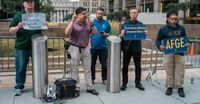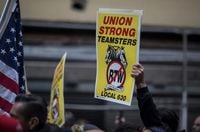In a sweeping and unprecedented move, President Donald Trump’s administration has stripped union protections from hundreds of thousands of federal workers, igniting fierce legal and political battles across the United States. The executive orders, issued in March and expanded in late August 2025, have targeted nearly one million federal employees, with over 445,000 losing their collective bargaining rights in August alone. The administration claims these actions are necessary for national security, but critics and labor leaders call it the most significant attack on unions in American history.
On September 1, 2025, Maryland and 22 other states, along with the District of Columbia, filed a friend-of-the-court brief with the 9th U.S. Circuit Court of Appeals. Their aim: to support federal labor unions in their lawsuit challenging Trump’s executive orders. The brief argues that the president’s directives violate federal workers’ First Amendment rights and punish them for opposing his political agenda. "Federal workers constitute one in ten Maryland jobs, serving our communities in roles such as nurses at veterans’ hospitals, environmental scientists, agricultural inspectors, and administrative support specialists," Maryland Attorney General Anthony Brown said in a statement. "These dedicated public servants deserve a voice in the workplace. Without the right to collectively bargain, they risk losing the protections, fair wages, and safe working conditions they need to support their families and serve the public effectively."
Trump’s initial executive order, signed on March 27, 2025, canceled labor agreements across agencies such as the Department of Defense, Department of Homeland Security, Bureau of Land Management, and the Federal Communications Commission. The rationale, according to the White House, was to "enhance national security." On August 28, Trump expanded the list, adding NASA, the Patent and Trademark Office, the National Weather Service, and the U.S. Agency for Global Media, among others. The order declared that these agencies’ "primary function" involved intelligence, counterintelligence, investigative, or national security work.
Federal unions, including the American Federation of Government Employees (AFGE), have not taken these changes lightly. AFGE National President Everett Kelley responded, "AFGE is preparing an immediate response and will continue to fight relentlessly to protect the rights of our members, federal employees and their union." The union has already filed more than a dozen lawsuits challenging the administration’s actions. The White House, for its part, has likened the union lawsuits to a declaration of "war."
The legal battle has been intense. On June 24, U.S. District Judge James Donato issued a preliminary injunction blocking implementation of Trump’s order, citing evidence of retaliatory animus. The White House’s own fact sheet had described "hostile Federal unions" that "have declared war on President Trump’s agenda" and are "‘fighting back’ against Trump." However, the 9th Circuit Court lifted the injunction on August 1, ruling that the order "on its face… does not express any retaliatory animus. Instead, it conveys the President’s determination that the excluded agencies have primary functions implicating national security." Since then, agencies have moved swiftly to terminate labor agreements, reclaim union office space, and cancel arbitration and grievance hearings, according to the Center for American Progress. The think tank estimates more than a million federal workers—about 81% of federal union membership—are affected.
Former acting U.S. Labor Secretary Julie Su has been among the most vocal critics, calling Trump’s actions a "war on workers." On September 2, Su condemned the administration for mass firings and stripping union protections from federal employees, warning of the long-term consequences for workplace democracy and employee rights. Organized labor, she noted, is actively fighting back, but the scale of the challenge is daunting.
The impact of these executive orders is already being felt by federal workers and the public they serve. According to reporting by The New York Times, nine agencies—including the Environmental Protection Agency, U.S. Coast Guard, FEMA, General Services Administration, and the Departments of Health and Human Services, Agriculture, and Veterans Affairs—have terminated union contracts covering more than 445,000 workers. At the Department of Veterans Affairs alone, 395,000 employees lost their union rights. The consequences are tangible: employees who previously negotiated for 16 weeks of parental leave now receive only the legal minimum of 12 weeks. Food service workers have lost meal allowances, and employees working long shifts are no longer guaranteed rest periods meant to ensure safety.
Union officials argue that these changes not only harm workers but also jeopardize public safety. Paula Soldner, chair of the National Joint Council of Food Inspection Locals, warned that inspectors at the Agriculture Department’s food safety division no longer have a formal process to raise safety concerns without fear of retaliation. "Inspectors are very reluctant to bring things to a supervisor’s attention in fear for their jobs," she said. "That could mean unsafe consumer products end up being sold to the public." At the VA, the loss of union protections has made it harder for employees to advocate for better patient care and address staffing shortages, according to Irma Westmoreland, a nurse and union leader. "Nurses continue to document concerns, but agency managers have not been as responsive because they no longer have to be," she explained.
The administration’s actions are part of a broader effort to assert more control over the federal workforce and make it easier to fire civil servants. Trump has also targeted independent boards that adjudicate employment disputes, further eroding protections for federal employees. Labor historians have compared the current campaign to President Ronald Reagan’s 1981 firing of air traffic controllers, which emboldened private employers to resist unions. But many argue that Trump’s actions go even further. "It is an action that’s almost incomparable in terms of what a president can do to undermine unions," said Joseph A. McCartin, a labor history professor at Georgetown University.
Meanwhile, the national picture for unions remains a study in contrasts. Public support for unions is at a near 60-year high, with 70 percent approval according to recent polls, and petitions for union elections have more than doubled in four years. Yet, national union membership has continued its decades-long decline, falling from 20.1 percent in 1983 to just 9.9 percent in 2024. California stands out as a notable exception. According to a University of California report, the state’s unionization rate was 16.3 percent in 2024, well above the national average, with 2.67 million workers covered by union contracts. California unions have played a major role in shaping state labor policies, from fast food wage laws to health care minimum wages, and have worked aggressively to organize workers in education, health care, and public service.
Enrique Lopezlira, director of the low-wage work program at the UC Berkeley Labor Center, noted, "In California, the union labor movement is pretty robust. It’s a testament to the continuing efforts of unions here to organize workers and to really get engaged in state-level policy to provide better opportunities for those workers." Despite the headwinds—rising housing costs, health care affordability, and technological change—California’s unions have remained resilient and innovative.
Still, the threat to labor rights is not confined to the public sector. A recent decision by the Fifth Circuit Court of Appeals, if upheld, could allow the president to fire National Labor Relations Board members, undermining a key institution for private sector labor law. Labor historians and analysts warn that the erosion of federal employee rights could embolden private employers to further resist unionization efforts. As Mike Podhorzer, former political director of the AFL-CIO, bluntly put it, "This is literally the largest act of union busting in American history."
The stakes could not be higher for American workers and the future of the labor movement. With legal battles raging and the administration showing no signs of backing down, the coming months will be a critical test of the resilience and relevance of unions in the nation’s workplaces. For many, the fight is about more than contracts or wages—it’s about the fundamental right to have a voice at work.





